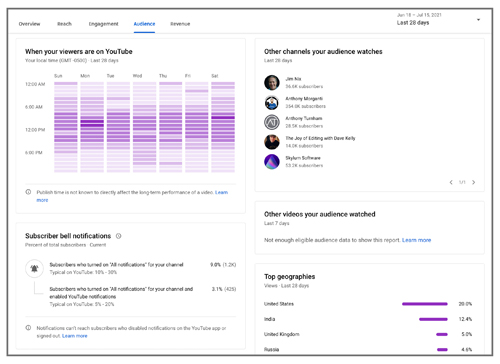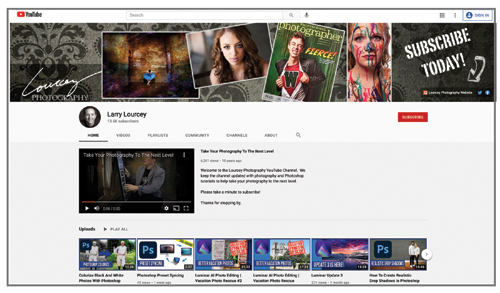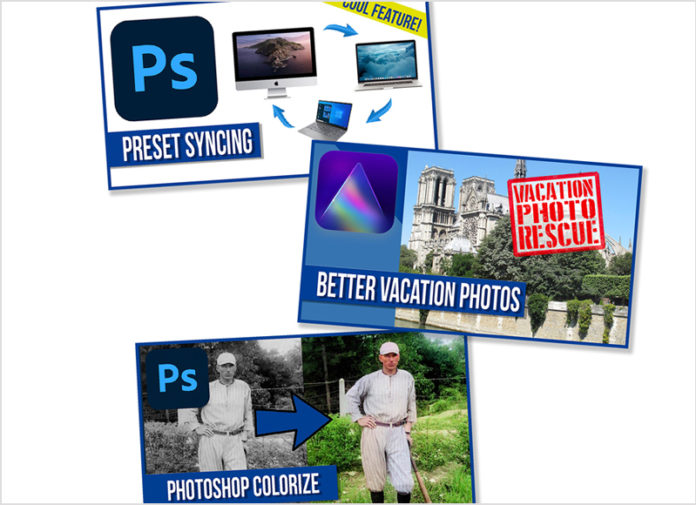Your Own YouTube Channel
by
Larry Lourcey
When the pandemic hit last year, most of us found ourselves with a little bit of extra time on our hands. I decided to use that opportunity to dust off my old YouTube channel and start creating new content. Although I started my channel about 10 years ago, somewhere along the way, I stopped uploading. Lonely tumbleweeds danced across my channel’s home page. It needed a reboot.
Resurrecting the channel was the perfect Covid-friendly activity because it didn’t really require going anywhere or interacting with anyone. It was a wonderful way of interacting with the world when we couldn’t interact in real life.
I’m often asked why I even have a YouTube channel. For me, it came about from my experiences teaching photography. I started noticing that people at conventions across the country all seem to ask the same questions. Things like composition, exposure, and other photography basics kept resurfacing and I found myself answering the same questions over and over again. That’s why I decided to setup a YouTube channel, fill it with basic tutorials, then just refer people to the site. Things just kind of took off from there. As I got more involved in the process, it became clear that it truly was a great way to engage with a world-wide photography audience. In fact, almost 5 billion YouTube videos are watched every day!
If you don’t already have a YouTube channel, I urge you to think about it. Although we are very fortunate here in Texas to have a thriving photographic community, many states struggle to gather more than a few dozen attendees at their state functions. More and more people are turning to online sources for their information and it is a great opportunity for those who have knowledge to share. I have met many amazing people via my channel and even been asked to speak on a few occasions from people who discovered me online.
It can also be a great asset to your studio’s marketing plan on a couple of different levels. For starters, it is a great way to drive traffic to your website. If you sell any sort of photography or photo education products, your YouTube audience can easily be directed to your sales page. If not, you can still reap the SEO benefits of dropping the occasional link to your website into your video description.

You can also start to build social proof and establish yourself as someone who is a photography educator and respected within the photographic community. This is a great way to assure new clients that you have the knowledge and skills necessary to provide them with a fabulous product.
An often overlooked part of the strategy is the ability to show off your personality and highlight your brand. Are you a straight-laced, down-to-business photographer or someone who is part photographer/part comedian? A few minutes of watching someone on YouTube can give you a really good insight into their style, their brand, and what they are like to work with. Obviously, this can work for you or against you. So it is important to have a clear plan in place and make sure your video work reflects your intended brand.
Perhaps the biggest incentive for many is the potential for financial gain. A thriving YouTube channel with a large following can easily bring in hundreds or even thousands of dollars a month in Google Ads revenue. From there you can add in your own product sales, affiliate payments, and perhaps even free products that companies want you to endorse or review.
The bad news is that these benefits won’t start showing up for quite a while. In most cases, your return on investment is going to be very low (probably zero) for the first year or so. In fact, you won’t even be able to get any of the financial benefits like ads until your channel has reached a certain size… 1000 subscribers and 4000 hours watched in the past 12 months. Let me assure you, unless you are extremely lucky or already have a big following on another platform, that doesn’t happen overnight. By the time your channel gets to the point that it is actually making money for you, the time investment will already have been hundreds of hours of work.
Building a new channel takes time and a good deal of work. It really has to be something you are passionate about or you will burn out quickly. You need to plan on posting a new video at least once a week for several months. That kind of consistency is the route to growth. Without growth, you are just making videos and nobody is watching them. Over 300 hours of video are uploaded to YouTube every minute… every minute! Obviously, this makes for an extremely competitive environment.
If you are still reading after that last paragraph, you probably have a passion for doing this, so you are already off to a good start. The actual “how to” part of creating a channel is pretty straight-forward: sign up with YouTube, make videos, upload videos, rinse and repeat. It is the planning and preparation that will set you up for success or doom you to failure.
When you set out to create a channel, it is critical that you do your best to define as specific a niche as possible in order to create content that will appeal to your audience. In my case, I started with “photography” and have narrowed my focus to be “intermediate level photography and photoshop tutorials.” If I’m brutally honest, it would be better to have an even more precise focus such as only the photography or photoshop part. I just don’t have that kind of discipline. So mine tends to drift back and forth a bit. Without question, that has slowed my growth. So do as I say, not as I do.
Once you have your audience in mind, the next big thing is content. It cannot be overstated how important good content is to the success of your channel. The problem is: How do you decide what to create? I think it helps to think of your topics as falling into two different categories. Things that YOU want to talk about and things that YOUR AUDIENCE wants to hear about. Obviously, the latter will get a lot more traffic. However, if you spend a year making videos that don’t interest you, burnout is the certain outcome.
Certain topics always tend to get good traffic. For example, if Canon is coming out with a new camera, there will be a bunch of people looking on YouTube for reviews of the camera, setup help, etc. If Photoshop comes out with a major update, there will be people looking for help with the new tools. These timely videos can be great traffic generators but they may not be the type of thing that you really want to make videos about.
The key is to create a mix of the two. For example, make a plan to post one video per week and alternate between timely/current content and videos that you find interesting. These will work in tandem to drive new viewers to your channel and still allow you to show off your personality. The timely videos will surely get you more views but it will absolutely crush your soul to exclusively create content that you aren’t passionate about. By mixing up the two, you can keep your sanity and see a moderate amount of success.
Much like when you first learned photography, you are going to have to invest some time educating yourself on the best practices for a channel. Hours spent watching videos on creating catchy thumbnails or learning about audience analysis will do wonders to decrease the learning curve and get you where you want to go faster.

Remember, the analytics information is your friend. Even if you aren’t a big fan of numbers, these particular numbers are important. Knowing the demographics of your audience will greatly aid you in determining things like when to post, what kind of thumbnails to produce, etc.
One last suggestion would be to get organized. By creating a content calendar and planning out a couple of months worth of videos, you will save yourself the agony of staring at a blank computer screen trying to figure out what your next video will be about. I tend to film 3 or 4 videos at a time, get them all edited and schedule them to YouTube. That way, I don’t have to worry about it for a few weeks. Believe me, if you try to do them one week at a time, you will constantly run into distractions and scheduling obstacles. Treat it like a job, because it really is a job.
Perhaps more than anything, it is important that you know what you are getting into. You won’t be an internet celebrity overnight. Those channels you see with 100,000 subscribers probably were not created in the past 6 months. They have likely spent 7 or 8 years building up that kind of following. Much like a photographer opening up a new studio, you have to identify your desired client and then make a plan to pursue them. There just isn’t any shortcut. However, if you enjoy the process and are passionate about learning the ropes, it can be a fantastic experience.
 Larry is a portrait artist and educator based in Plano, Texas. He started his YouTube channel over ten years ago and has grown it to thirteen thousand subscribers and well over a million views. You can see for yourself at www.youtube.com/LarryLourcey
Larry is a portrait artist and educator based in Plano, Texas. He started his YouTube channel over ten years ago and has grown it to thirteen thousand subscribers and well over a million views. You can see for yourself at www.youtube.com/LarryLourcey











